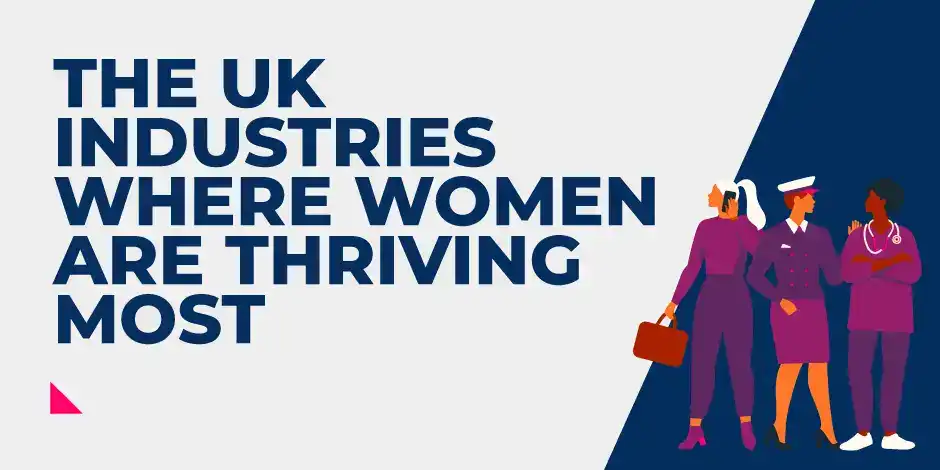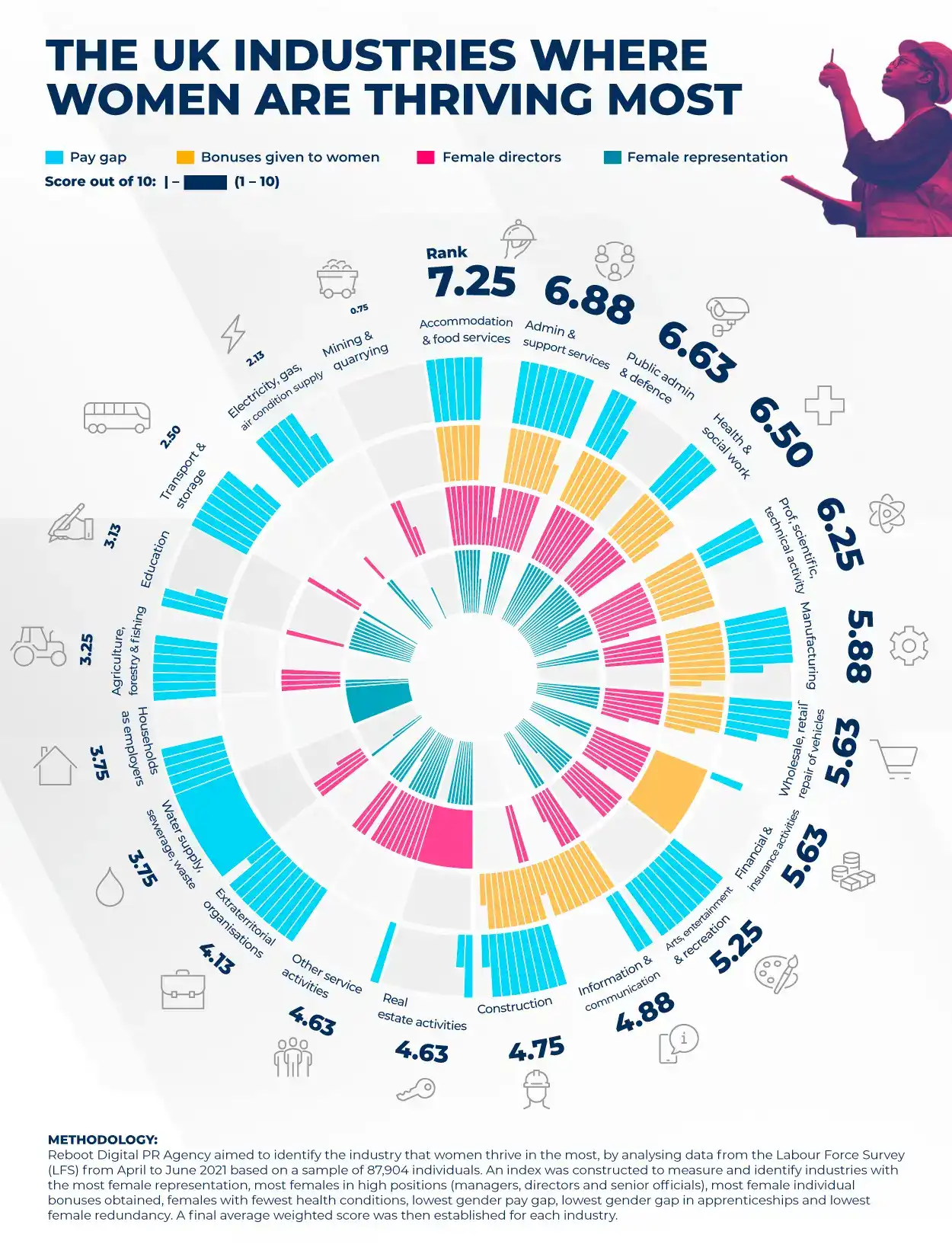
The UK Industries Where Women Are Thriving Most
There’s no denying that women continue to face barriers to progression in the UK workforce. Looking ahead, our CEO and co-founder, Naomi Aharony shares that ‘introducing better benefits and flexibility will enable women at work to experience less burnout, increase motivation and progression, encouraging not only a better working environment but also an exploration of other unexpected career paths.’
However, the last decade has seen more women moving into traditionally male-dominated industries, as well as a rise in female entrepreneurs. As of 2021, 72.1% of women are employed, a percentage that has risen from 52.8% in 1971.
Although the representation of women in the UK is steadily increasing, which industries are seeing the most success when it comes to narrowing the gender gap?
Our data and digital PR specialists sought to find out by analysing data from the Labour Force Survey (LFS) from April to June 2021, based on a sample of 87,904 individuals (who were employed, self-employed or were in a Government scheme at the time of the survey, and were made redundant over the last three months).
Overall, the industry where women are thriving the most

Women have long battled obstacles in the workplace as they fought for equality with their male colleagues. However, our results reveal that women have made huge strides in the food and services sector. Gaining a score of 7.25 out of 10, and ranking first, this industry has emerged as the most successful sector which is supported and managed by a female-centric workforce.
Women are also breaking ground in the administrative and support services industry, which ranked second, scoring 6.88 overall. The third, fourth and fifth positions also had similar results - public admin and defence (6.63), health and social work (6.50), and professional, scientific and technical activities (6.25).
Many jobs in the economy are gender-stereotyped, and there’s a widespread perception that engineering is a career path for men. But considering that only 11% of UK engineers are female, it’s promising that the manufacturing industry was sixth on the list of industries where women are thriving the most. This industry had a score of 5.88. The wholesale, retail and repair of vehicles sector, and the financial and insurance activities sector had comparable results. These industries scored 5.63 out of 10, ranking them joint seventh.
The influence of women in arts, entertainment and recreation is perhaps greater now than ever before, and with an average score of 5.25, this industry has made it to the top ten. A sector that has also hit new highs in recent years in regards to diversity in entertainment, Black women celebrated wins in TV throughout 2021 - AJ Odudu had won the second series of ITV2’s Celebrity Karaoke Club, and the star spoke openly about the challenges she faced in pursuing a career in broadcasting and TV. So, appearing that year on the BBC’s Strictly Come Dancing, where she became a finalist, was a dream come true.
She shares that ‘social media and different platforms have been a wake up call to the world of television. If there isn’t a diverse range of people on TV then people will make their own podcasts or programmes.’ As Strictly represents the capstone of her career, we hope the industry will stay committed to achieving equality.
In the 10th spot in our survey was the information and communication sector, which had a score of 4.88.
The industry with the most female representation
As the world continues to strive for parity between male and female workers, the top three industries with the highest female representation prove to be successful examples of that - Ranking first was households as employers (76.25%), followed by health and social work (75.87%), and third, education (72.07%).
Also among the top five industries was other service activities (62.59%) - this industry includes activities of professional membership organisations, trade unions, religious organisations and personal service activities, like hairdressing and dry-cleaning. The next industry on the list, and in fifth place, was public admin and defence, with 52.36%.
With roughly half the representation of public admin and defence, was agriculture, forestry and fishing. This industry made it into the bottom five industries, with a percentage of 26.18%.
Also among the bottom five industries was water supply, sewerage, waste (23.40%), transport and storage (22.33%) and mining and quarrying (18.61%).
With a staggeringly low representation of women, the construction had the lowest ranking. This sector had 14.26% - about five times less than the industry that took the top spot - households as employers.
The industry with the most females in higher positions of leadership
While women have advanced their careers up the corporate ladder and attained well-deserved executive seats, these positions are still largely dominated by male executives. This is shown by lower percentages in this category. For example, although the leading industry with the most females in higher positions of leadership was real estate activities, its result was only 13.45%. And, at roughly half this figure, were the accommodation and food services sector (6.81%) in second place, and other service activities in third place (5.31%.)
Also with low percentages were professional, scientific and technical activities (4.81%), which was in fourth place, public admin and defence 4.30% (in fifth).
Among the bottom five, the construction industry showed a significant drop when compared to female representation in the real estate industry, with a percentage of 1.97%. The following industries had comparable results - transport and storage (1.80%), education (1.73%) and electricity, gas and air condition supply (1.17%).
Last on the list was the households as employers sector, which showed no representation of women in higher positions of leadership.
The industry with the most female individual bonuses obtained
While transparency in pay has come on leaps and bounds over the past decade, there’s still a clear gap, as women are still receiving less in bonus payments than men. The results show that although ranked as the industry with the highest percentage of female employees that were paid an individual bonus, the financial and insurance activities industry had a low percentage of 1.09.
With roughly half that figure, the information and communication sector was second, with 0.62%, and the manufacturing sector was third (0.55%).
The fourth, fifth and sixth industries saw similar results - construction (0.47%), professional, scientific and technical activities (0.45%) and admin & support services ( 0.43%).
The average female pay gap in hourly pay as a percentage of women’s pay
As the leading industry where female employees are paid more than men, water supply, sewerage and waste took the top spot, with 17.13%.
The next industry to follow was extraterritorial organisations at 12.86%, securing the second position. This industry includes activities of international organisations, such as the United Nations and the World Bank. Also in the top five industries were arts, entertainment and recreation (7.08%), the male-dominated construction sector (4.63%) and admin and support services (1.85%).
Despite the progress of these industries, the results also highlighted the sectors where female employees are paid shockingly less than men - women are still earning less than men across the mining and quarrying sector. A significant pay gap of -95.14% placed this sector at the top in this category.
The financial and insurance activities industry also made it to this category, with -56.73%. Showing similar results were the other services sector(-37.57%), real estate activities (-34.11%), and information and communication (-32.44%). So, these were the top five industries where women are paid less.
Final thoughts
It’s promising that of all the industries included in our survey, over half had an overall score of 70 for women’s opportunities. And as we continue to fight to eradicate the gender pay gap, it’s great to see that women are being paid more than men in the water supply, sewerage and waste sector (17.13%) and even in construction (4.63%). However, despite these wins, there’s still a lot of work to be done in the battle for true equality.
Methodology:
1. Reboot Digital PR Agency conducted an index study with the aim of identifying the industry that women thrive in the most. This study analyses quarterly data from the Labour Force Survey (LFS) for April to June 2021 based on a sample of 87,904 individuals.
2. This study is based on data from the Labour Force Survey (LFS) which studies employment circumstances of the UK population.
3. The sample was filtered by employment status focusing on employees, self-employed, government scheme and unpaid family workers.
4. An index was then constructed to measure and identify industries with the most female representation, most females in high positions (managers, directors and senior officials), most female individual bonuses obtained and the average female pay gap.
5. To ensure the survey samples are representative of the population they describe, population weighting variables (PWT20 and PIWT20 for hour pay) provided by the Office for National Statistics (ONS) and contained within the LFS dataset were used.
6. To conclude the research, a final score was established by normalising the data using the average percentrank.inc function and giving an average weighted score for each industry.
7. Data was collected on 21st September 2021 and is subject to change.